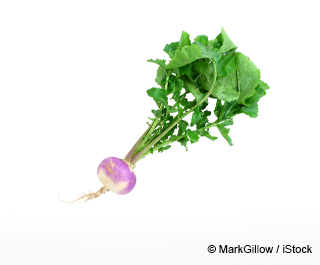Terrific turnip
Botanical name: Brassica rapa

The turnip is a root vegetable from the Brassicaceae family that has been enjoyed since ancient times. It’s white at the bottom with a light purple blush around the top, which appears when the plant has been exposed to sunlight.1
Turnips are native to middle and eastern Asia, and thrive best in cool spring and fall weather, growing up to 1.5 feet high, with long and slender hairy leaves.2 You can buy them all year round, but they’re best enjoyed during spring, when they are small and sweet.3 The larger the turnip, the tougher its texture and the stronger its flavor.4
Like other root vegetables, turnips are a great storage vegetable that you can stock before winter arrives. When buying this crop, look for firm and heavy roots that have a smooth skin, sweet aroma and crisp green tops.5,6
Turnips have a distinct “hot” flavor that complements many dishes. They can be roasted, baked, mashed or mixed with cherry tomatoes and olives to make a delicious appetizer. You can also mix them in stews alongside vegetables like carrots and kohlrabi.7
Before cooking or serving turnip, make sure you clean it thoroughly by scrubbing the skin with a vegetable brush under running water. It has a great crunch and texture, so make sure not to overcook. Don’t throw away the leafy green tops — they are actually rich in vitamins, minerals and antioxidants.8,9
Health Benefits of Turnip
Turnip root is a low-calorie vegetable rich in nutrients, antioxidants and dietary fiber. It’s loaded with immune system-boosting vitamin C,10 which is also essential for collagen synthesis, as well as for scavenging free radicals that may increase the risk of cancer and inflammation-related diseases.11
Turnip greens are rich in other free radical-scavenging antioxidants too, such as vitamin A, lutein, zeaxanthin and beta-carotene.12 Plus, they’re a source of vitamin K,13 a direct regulator of inflammatory response,14 as well as magnesium,15 which is “a cofactor in more than 300 enzyme systems that regulate diverse biochemical reactions in the body,” according to an article in the journal Nutrients.16
The leafy green tops contain folate, calcium and potassium, as well as trace amounts of riboflavin, pantothenic acid, thiamin, copper, manganese and iron. Turnips also have flavonoids like quercetin and kaempferol,17 which may help lower your risk for oxidative stress.18 Check out the table below to learn more about the nutritional value of turnips:19
Turnip Nutrition Facts
Serving Size: 3.5 ounces (100 grams), raw
| Calories |
28 |
|
| Total Fat |
0 g |
|
| Saturated Fat |
0 g |
|
| Trans Fat |
|
|
| Cholesterol |
0 mg |
|
| Sodium |
67 mg |
|
| Total Carbohydrates |
6.43 g |
|
| Dietary Fiber |
1.8 g |
|
| Sugar |
3.8 g |
|
| Protein |
0.9 g |
|
| Calcium 30 mg |
Iron |
0.3 mg |
Studies Done on Turnip
The beneficial plant compounds in turnip are found to have health-promoting effects. One example is brassinin, a type of indole compound which was found to help reduce your risk for colorectal and lung cancer. According to a tissue culture study published in the March 2012 issue of the International Journal of Oncology, brassinin may help kill human colon cancer cells. This was also the first study that determined the particular stage of cancer cell growth that the turnip compound affected.20
Glucosinolates, which are sulfur-containing compounds found in turnip sprouts, may have anticancer, antifungal, antiparasitic and antibacterial benefits.21 According to the November 2012 issue of the Journal of Agricultural and Food Chemistry, turnips have the second highest level of glucosinates (next to white mustard sprouts) among nine different cruciferous vegetables studied.22
Turnip Healthy Recipes:
Roasted Cauliflower With Turnip and Dulse

|
Ingredients:
|
|
✓ 1 large head cauliflower or broccoli
|
✓ 1 turnip
|
✓ 2 tablespoons coconut oil
|
✓ 1 clove garlic, pressed
|
|
✓ 2 tablespoons dulse granules
|
✓ 1 tablespoon fresh rosemary, chopped
|
✓ Salt and pepper to taste
|
|
Procedures:
- Heat the oven to 350 degrees Fahrenheit.
- Wash the cauliflower and cut it into florets, and then slice the turnip thinly.
- Toss the turnip with the coconut oil and garlic, and then sprinkle with dulse.
- Place the cauliflower and turnip in a casserole dish and bake until brown, or about 45 minutes.
- Remove from oven and season with salt and pepper.
(From “Healthy Recipes for Your Nutritional Type” by Dr. Mercola)
Turnip Fun Facts
Turnips are often eaten cooked, but they can also be enjoyed raw. Baby turnips — small, young, all-white turnips that have been harvested early in the growing stage — are enjoyed by many for their delicate and sweet flavour, and are frequently added raw to vegetable salads.23
Summary
If you’re looking for a hardy, cool-weathered root crop to store before winter arrives, turnips certainly fit the bill. With vitamin C, magnesium and cancer-fighting plant compounds,24,25 they’re a healthy vegetable to add to your diet. Don’t forget the leafy green tops — they are nutritionally dense as well.26,27
Although turnips are not as flavorful as other vegetables, this unique, white and purple root crop is versatile and can be used in a vast array of dishes. From crunchy appetizers and salads to rich soups and stews, turnips can augment your favorite recipes with their subtle flavor. Just make sure not to overcook it to retain its trademark crunchiness.28